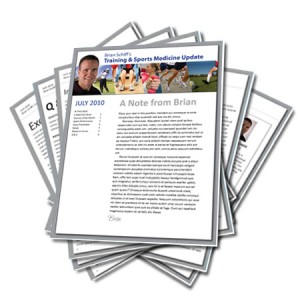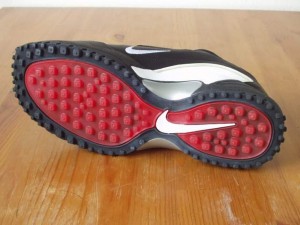Brian Schiff’s Blog
Injury Prevention, Sports Rehab & Performance Training Expert
It is no secret that the average male gym goer loves to do plenty of bench press exercises. I was out at a piano bar last weekend celebrating the 10 year wedding anniversary of some close friends and witnessed the “bar body” syndrome firsthand.
For those not familiar with this lingo, the “bar body” belongs to the guy who overworks the chest and biceps, while typically neglecting the back leg muscles altogether. They routinely sport tight t-shirts and jeans even in the dead of summer in Ohio.
I spotted the bouncer right away. He was likely 25 years old and obviously proud of his caveman posture and large stature. What he does not know is that in 5-15 more years he will likely suffer significant shoulder impingement and AC joint arthritis, not to mention he will have little to no upper body flexibility.

Know anyone that fits this description? Look around in your local health club and you will surely find them. So, the takeaway messages are:
- Perform back to chest strengthening exercises in a ratio of 3:2 or even 2:1 to promote balance and better posture
- You do not need to bench press all the time (once per week is sufficient and may even be too much for some)
- You should do routine flexibility exercises for the chest as these muscles are tight in most of the population and they can contribute to increased internal rotation of the shoulders and rotator cuff problems
In light of this, I want to share a few effective exercises from my brand new Training & Sports Medicine Update Newsletter. To view these exercises, click HERE.
If you enjoyed this information, you can get even more info on exercise, recent research, sports performance training, injury prevention and rehab delivered to your inbox monthly by signing up for a subscription to my newsletter. You can grab the digital version for just $9.95/month. By subscribing, you are become eligible for immediate product discounts and promotional pricing on all new items.
Click here to sign up and get the entire first issue today!
In health,
Brian
A quick note for those who follow my blogs. I have been wanting to launch two new information based platforms this year: a monthly printed newsletter and online membership site. What I have realized is that I am so busy I will likely not get both done in 2010 as I am also working on my Fit Knees DVD series as well as running my training business.
So, I have prioritized the printed newsletter titled Brian Schiff’s Training & Sports Medicine Update. My love and passion lies in sports medicine, injury prevention and sports performance training. So, the newsletter will have the following components:
- Exercise of the month – I will share pics and how to info with you
- Sports performance – topics relevant for athletes and weekend warriors
- Injury prevention – tips on how to stay injury free
- Rehab – advice on how to rid yourself of aches, pains and injuries
- Research corner – review of current pertinent research and trends
- Q & A – ask me your own questions about training and injuries
My goal for this publication is to deliver solid up to date information for coaches, ATC’s, physical therapists, parents, weekend warriors and athletes seeking information on how to be their physical best and remain injury free. You can see the art for the inaugural issue soon to be released below.

For more information and to stay updated on the official launch, be sure to sign up for my newsletters at www.brianschiff.com. I will be offering a special launch price to the first 100 subscribers. I look forward to helping you stay healthy and performing optimally for many years to come.
It has been known for years that increased coefficient of traction can predispose the knee to catastrophic injury. Hence, the reason we got rid of all the old style astro turf in football stadiums. But, traction is influenced by the sole architecture of the shoes as well as the playing surface. Unfortunately, we are not fully aware of how exactly the sole architecture or this increased traction can lead to injury.

Nike Astro Turf Shoe
Does footwear really matter? I say YES. Case in point – I am not a big fan of Nike Shox because they position the ankle in a plantar flexed position, thereby making it so much easier for ankles to roll inward with cutting. I have seen too many female athletes suffer inversion sprains while running suicides or training in these shoes. I simply believe the design creates a biomechanical mismatch and elevated risk for ankle sprains.
Now what about traction? A study in the American Journal of Sports Medicine by J Wannop et al. recently looked at the difference between two shoe designs in a controlled laboratory study. The tread types of shoes used were either smooth or tread.
The shoe used in the study was the adidas Response 2+ CPT (smooth shoe) and adidas Response=2(A) (tread shoe). The traction testing was performed using a robotic testing machine, while the researchers also observed 13 recreational athletes performing 45 degree V cuts in both shoes. Data was collected using 8 high speed cameras and a force plate.
The results are not shocking. The highlights are:
- The coefficient of translational traction and peak moment of rotation were both significantly higher in the tread show compared to the smooth shoe.
- In addition, the high-traction shoe had much higher peak ankle externalrotation moments, peak knee external rotation moments, peak knee adduction moments, and knee adduction angular impulse compared to low-traction shoe.
The findings of the study indicate that the resultant joint loading increased 12% in the ankle (transverse plane) and 13% and 20% in the transverse and frontal planes for the knee. This increased traction is certainly enough to push the knee into the previously reported mechanical rupture zone.
What we cannot deduce is whether the increases in joint loading is strictly attributable to the higher linear and rotational traction or if there is even a linear relationship between them at all.
You should also note that athletes often choose traction shoes for enhanced performance. In this study, there was no significant difference in the performance measured between the two groups. So, we are left to ponder whether we really need higher traction shoes at all. Future studies will need to address this relationship as preventing knee and ankle injuries just by adjusting footwear seems like a no-brainer if the science supports this.
I have been rehabbing rotator cuff injuries for the better part of 13 plus years now. I also have the privilege of teaching fitness boot camps, educating other fitness pros on training/rehab and training athletes. One of the most common issues I encounter in my work is rotator cuff pathology (tendinitis, tears, etc.).
I have sold well over 10,000 copies of my Ultimate Rotator Cuff Training Guide (e-book and print versions) since its release in 2004. While most of the training methodology is still sound today, I wanted to add some new content and tweak a few progressions. Like anything, with time you gain more experience and wisdom.
In addition, many people were asking me for the DVD version to better understand how to perform the exercises. So at last, I have released the DVD version. Some of the new additions include:
- Soft tissue mobility exercises
- Self assessment screening tools
- Integrating a towel roll with rotation exercises
In addition to the DVD itself, you get a companion CD-ROM with my Self Stretching Guide, personal interview on rotator cuff injuries, my 60 minute rotator cuff explained power point and audio seminar, the entire updated rotator cuff e-book, and 5 second video clips of each the particular exercises in the rehab plan.
I am selling this product for $49.95, but until next Wednesday (June 16) you can get it for only $29.95.
Click here to see a sample clip from the DVD
If you decide to grab a copy, simply use the code BFITCUFF (all caps) at checkout and be sure to hit apply to get credit for the coupon. You can order at www.brianschiff.com.
This DVD is ideal for people with acute or chronic nagging shoulder pain related to bursitis, scapular imbalances, rotator cuff tendinitis and rotator cuff tears. As always, I offer a 60 day money back guarantee on all my products. If you have any questions, simply post them on the blog.
Here’s to happier and healthier shoulders!
So, I was meeting with a 14 y/o soccer player referred to me by a physical therapist today who is need of sports performance conditioning (return to play) work after a lateral release. This talented female athlete suffers from a shallow trochlear groove, thereby making her more prone to patella subluxations.
Such an incident led to two recent surgeries and nearly a year away from the soccer field. She has returned to soccer, but has been referred to me for prevention and performance work. I have been thinking about her program, history and all the athletes I have trained in recent memory with knee problems.
I also recall reading an email this weekend from a past intern asking me if there was a single leg training certification out there as she saw me do so much of it at my facility. These thoughts lead me to my post today. If you are a jumping, cutting or competitive athlete using your legs to perform, you should absolutely be integrating single leg training into your conditioning programs.

Why, do I say so? The answer is rather simple in my mind. The human body is often out of balance. The brain is so adept at mastering movement, it learns to compensate for even the slightest deficits on one side. Over time, you end up grooving improper motor patterns and these tend to lead to small imbalances or even overuse issues.
Ever hear about stretch weakness or adaptive shortening? Maybe you are familiar with the terms overactive and under active muscles? Regardless, I can assure you that at any given moment, your body may be susceptible to these patterns.
Through a poper single leg assessment, I see many issues come to light that may otherwise be hidden with two legged squats, lunges, leg press, etc. Let me go back to the young lady sitting in my office this morning. She has bilateral shallow trochlear grooves, yet only one knee to date has given way. Why so? Will the other one follow suit?
There is no way to definitively predict if her other knee will become problematic. But, my hunch is there were some single sided imbalances that may have led to her current injury history. It is now my job to try my best to prevent such an episode on her other knee, as well as make sure she does not have issues on the surgically repaired side.
Anything short of a program heavy on single leg work would be a mistake for her (and many others like her). You see, we often reinforce imbalances and poor technique with heavy squatting, lunging and dead lifts seen in traditional programs. I am not oppose dot these lifts – in fact they can be great for strength and power development.
However, we MUST address and correct the single sided imbalances first. We must also always include some single leg strength work with our athletes to ensure there is no asymmetry developed unknowingly. Most athletes compete using their own body weight. We must train in such a way that we foster control, power and mastery of movement with each limb.
This focus and approach will be most helpful in reducing injuries like ankle sprains, ACL tears, muscle strains and common overuse issues in the lower extremity. So, next time you think about performance training, I want you to consider the importance and relevance of single leg training. No program is perfect. But, I will tell you my track record is pretty solid with prevention, performance and return to play training I have done that relies heavily on this approach to conditioning.
Stay tuned as later this week I will unveil my latest DVD as well as review how traction with footwear affects lower limb joint loading.

